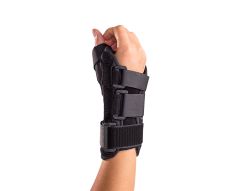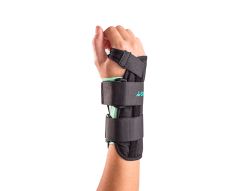Carpal Tunnel Syndrome (CTS)
The carpal tunnel is a space on the bottom of the wrist that contains several bones, tissues, tendons and the median nerve. This nerve is responsible for providing sensation to the palm side of all fingers except the pinky, and it helps control the muscles around the base of the thumb. When the tendons within the carpal tunnel thicken or swell, it narrows the small space of the tunnel and crowds the median nerve. This results in carpal tunnel syndrome, a common nerve disorder of the hand and arm that affects approximately 4-10 million Americans.
What Causes Carpal Tunnel Syndrome?
Anything that crowds, irritates or pushes on the median nerve can cause carpal tunnel syndrome. Unfortunately, the exact cause of the condition is unknown in most cases, and there may be a number of factors that contribute to its development.
Heredity is considered the most important risk factor for carpal tunnel syndrome, as some people who inherit a smaller carpal tunnel will be more likely to develop it. Other risk factors that are associated with CTS include pregnancy, arthritis, obesity, endocrine disorders like diabetes, wrist fracture and alcoholism. Middle-aged women are at an increased risk because the condition is most common in their demographic, and there is also a high rate of occurrence in most racket sports, handball, swimming, golf, rock climbing and any other sport with prolonged use of the hand and wrist. Athletes of these sports are therefore at an increased risk for CTS.
It has been suggested that repetitive work activities, such as typing or frequent keyword and mouse usage and other regular tasks, can also cause carpal tunnel syndrome. It is not clear if this actually causes the condition, but it appears that repeatedly performing certain tasks—especially those that produce vibrations such as from power tools—can worsen its symptoms.
What are the Symptoms?
Patients with carpal tunnel syndrome usually notice a burning or tingling sensation first, but this will eventually lead to pain, weakness or numbness in the hand and wrist. This is usually felt most in the thumb, index and middle fingers, and these strange sensations and pain may also travel up the arm towards the shoulder. Symptoms tend to be worse at night from the curling of the wrist, and though most patients only deal with problems on one side, CTS can affect both sides of the body in some cases. As a result, these symptoms will typically have a negative affect on hand strength and sensation, and cause a decrease in hand function that will make performing certain daily tasks more difficult.
What is the Treatment?
If you have symptoms that suggest carpal tunnel syndrome, it’s always best to see your physician first to confirm the diagnosis and determine the best course of treatment. In most cases, CTS will get progressively worse if nothing is done about it, but it is possible to stop it from progressing with proper treatment. It is therefore important to treat it as early as possible, preferably right after symptoms begin. Diagnosing and treating carpal tunnel syndrome in the early stages can relieve symptoms, prevent the need for surgery, and help you recover faster. Typical recovery time can be months if you start treatment early to years if you have been dealing with CTS for a long time and have not sought treatment.
Home Remedies
Unless your condition is too severe or has progressed too far, your physician will always prescribe a conservative (non-surgical) course of action first.
Rest
If certain activities are responsible for making your pain and symptoms worse, they will instruct you to reduce the amount of time you perform them or to take more frequent breaks.
Immobilization
Some doctors may also recommend that you use a splint or brace, such as the AirCast A2 Wrist Brace or DonJoy ComfortFORM Wrist Support. These are mainly intended to be worn at night and will help to keep the wrist in a neutral position that will prevent nightly irritation of the median nerve. Immobilizing the wrist will also force you to give your wrist a break which can help bring relief to your symptoms.
Massage & Stretching
Spending several times throughout the day to stretch your wrists upward, downward, inward and outward can help loosen the tendons in your wrist and forearm which connect down to the ligaments in your fingers. Massaging the inner (anterior) part of your forearm can help breakdown scar tissue and inflammation while releasing the pressure on the median nerve. Frequently massing and stretching the forearm, wrist, and fingers can help alleviate symptoms over time and prevent CTS from happening in the first place.
Physical Therapy
Some physicians will refer you to a physical therapist for additional treatment. The goals of physical therapy are to reduce your symptoms and help you become as active and functional as possibly, while also avoiding the need for surgery. Treatments will usually include education on proper neck and upper back posture, how to change your wrist positions and promoting regular stretch breaks during the day. Exercises to strengthen the muscles in the hand, fingers and forearms, as well as stretching exercises to improve flexibility of these regions are also used, and heat and cold treatments may be prescribed to reduce pain.
Surgery
When these measures fail to relieve symptoms of carpal tunnel syndrome, surgery may be needed. The surgical procedure for this condition is called carpal tunnel release, which opens up the carpal tunnel in order to relieve pressure on the median nerve. Physical therapy is often needed after surgery as well to help restore strength and modify habits that led to symptoms in the first place.
Can Carpal Tunnel Syndrome be Prevented?
Unfortunately, because its causes are often unknown and varied, there are currently no proven ways to completely prevent carpal tunnel syndrome. There are, however, some ways to minimize stress on the hands and wrists that may help with prevention. These include:
- Take frequent breaks especially when doing repeated activities, take a break and try performing some stretching exercises
- Relax your grip when performing tasks that involve the wrist to avoid strain
- Maintain a neutral wrist position this means keep your wrists straight and avoid bending them
- Modify work area eliminate anything that can be adding to the strain on your wrists
- Improve posture proper alignment of the rest of your body can prevent strain on your wrists
- Maintain good health keeping a healthy weight is beneficial for preventing many health conditions and may reduce your chances of developing CTS
Support & Protection for Carpal Tunnel Syndrome
View All Braces & Therapy Products for Carpal Tunnel Syndrome







